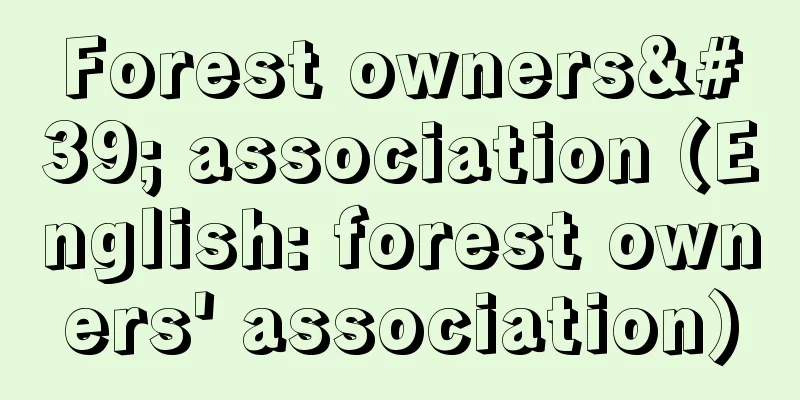Forest owners' association (English: forest owners' association)

|
An organization made up of forest owners. There are said to be two types of forest associations around the world. One is a forest association that is formed through compulsory membership of forest owners with the objectives of preventing forest degradation and planned timber production, and is an example of an organization established in Germany in the latter half of the 19th century. The other is a cooperative-style forest association with voluntary membership, with the objectives of jointly selling forest products and jointly purchasing materials, and is an example of such an association that exists in Sweden, Norway, and other countries. Modelled on Germany, forestry associations in Japan were first institutionalised in 1907 (Meiji 40) with the revision of the Forest Law, which established four types of associations: those for operation, afforestation, civil engineering and protection. However, forest owners showed little desire to set up associations, and most of those that were established were civil engineering associations, which did not have a significant impact on Japanese forestry. The revision of the Forest Law in 1939 (Showa 14), when the country was on a wartime footing, eliminated the distinction between the four types, and changed forestry associations to one association per city, town or village, with compulsory establishment and membership. They began to carry out economic activities such as timber production and sales, as well as activities that played a role in the administration of privately owned forests. Furthermore, as the wartime footing progressed during World War II, they also played a role as an organisation that supplied timber for military use through compulsory felling. After the Second World War, the Forest Law was completely revised in 1951 (Showa 26) in accordance with the policy of democratization of organizations by the General Headquarters of the Supreme Commander for the Allied Powers (GHQ), and forest associations were newly established as cooperative associations with voluntary membership, instead of the compulsory membership system that had existed until then. After the Basic Law for Forestry was enacted in 1964, under the policy of modernizing the forestry structure, they were nurtured as collaborative organizations that carried out forest management of privately owned forests on behalf of small-scale forest owners. In 1978, the Forest Association Law was enacted based on the provisions of the Forest Law, and forest associations became organizations operated under independent laws, and their scope of business was expanded. [Shigeru Iida and Noriko Sato] Japan's current forestry associationsThe Forestry Cooperatives Law (Law No. 36 of 1978) states that the purpose of forestry cooperatives is "to promote the development of cooperative organizations of forest owners, thereby improving their economic and social status, preserving and cultivating forests, and increasing forest productivity, thereby contributing to the development of the national economy," and stipulates that to achieve this purpose, two types of cooperatives will be established: forestry cooperatives and production forest cooperatives, as well as a federation of forestry cooperatives, which will be an affiliated organization. Of these, forestry associations play the most important role, and the term "forestry associations" usually refers to these associations. As of 2010, there were 691 associations, with approximately 1.58 million members, and the area of forest owned by members was approximately 11.08 million hectares, accounting for 68% of the privately owned forest area excluding prefecture-owned forests. The main activities of the associations are (1) planting and maintenance, (2) felling, processing, and sales of timber, (3) joint purchase of forestry materials, (4) counter services such as loans, (5) management guidance for members, and (6) other (greening tree production, measures for absentee village ownership, etc.). The associations are run by approximately 17,000 executives and 7,000 employees, and employ an additional 25,000 forestry workers who plant, maintain, and fell trees. On the other hand, the majority of production forest associations, accounting for about 80%, were established based on the law to eliminate the rights of common forests and promote new uses (Law Concerning the Promotion of Modernization of Rights Relations Pertaining to Common Forests, etc., Law No. 126 of 1966). As of 2010, there were 3,224 associations with approximately 300,000 members and a management area of approximately 350,000 hectares. There are 46 prefectural forestry association federations (excluding Osaka Prefecture), as well as the National Forestry Association, which has these and the Osaka Prefecture Forestry Association as members. The federation handles sales, purchasing, finance, forest insurance, and other tasks, and also provides management guidance to forestry associations. [Shigeru Iida and Noriko Sato] Forestry Association Management Issues and InitiativesAfter the Second World War, forestry associations were developed and supported as the backbone of forestry production, but the lack of human resources and funds necessary for business expansion became an issue. In 1962, the Forestry Association Merger Subsidy Act was enacted, and the number of associations decreased from 3,541 in 1962 to 1,620 in 1990, and to 691 in 2010. Wide-area mergers that go beyond the boundaries of municipalities and river basins have also been created. However, there are concerns that wide-area mergers will prioritize association management. With the long-term slump in timber prices, many small and micro-sized association members have lost interest in forestry, mountain villages are depopulating and aging, and the number of association members who are absent from the villages is increasing. Some forestry associations have prioritized public works that can ensure profits, increasing the proportion of non-member use, and the weakening of relationships with members has become a problem. In addition, the poor management of lumber processing factories and other wood processing plants managed by associations and the pressure on private businesses have also been pointed out. In this context, the 2009 Forest and Forestry Revitalization Plan stated that the top priority of forest associations would be to promote "proposal-based intensive management," in which forest associations would propose management practices to small-scale private forest owners, form local management complexes, and jointly carry out road network development and thinning to reduce management costs and return profits to association members. To this end, the plan pointed out the need to train forest association employees as forest management planners and for the government to equalize the competitive conditions between forest associations and private forestry businesses. Following the realization of the regeneration plan, the National Federation of Forest Owners' Associations launched a nationwide "Expanding the Use of Domestic Timber and Forests, Forestry, and Regeneration Campaign" in 2011. [Noriko Sato] "The Production Structure of Privately Owned Forests and Forestry Associations" by Shiga Kazuto (1995, Japan Forestry Research Council)" ▽ "Mountain Village Sustainability and Forests/Forestry" by Hori Yasuto (2000, Kyushu University Press)" ▽ "Forest Management Issues in Modern Japan" edited by Shiga Kazuto and Narita Masami (2000, National Federation of Forestry Associations)" ▽ "Modern Forest Policy Studies" edited by Endo Hikaru (2008, Japan Forestry Research Council)" ▽ "Forestry Agency ed., Forest/Forestry White Paper, various years' editions (Agriculture and Forestry Statistics Association)" [Reference items] | | |Source: Shogakukan Encyclopedia Nipponica About Encyclopedia Nipponica Information | Legend |
|
森林所有者が組織する団体。森林組合は世界的にみて二つの型があるといわれている。一つは、森林の荒廃防止や木材の計画的生産などを目的として、森林所有者の強制加入によって成り立つ森林組合で、19世紀後半に設立されたドイツの組織がこれにあたる。他の一つは、林産物の共同販売、資材の共同購入などを目的とし、任意加入による協同組合的な森林組合で、スウェーデン、ノルウェーなどに存在する組合が該当する。 日本の森林組合は、ドイツを範とし、1907年(明治40)の森林法の改正で初めて制度化されたもので、施業、造林、土工、保護の4種類の組合が設けられた。しかし、森林所有者の組合設立意欲は小さく、設立されたのは土工組合が大半で、日本林業に与える影響は大きくなかった。戦時体制に入った1939年(昭和14)の森林法改正では、4種の区別をなくし、1市町村1組合を原則とする強制設立・強制加入の森林組合に改変し、木材の生産・販売などの経済事業のほか、民有林行政の末端を担う事業も行うようになった。さらに第二次世界大戦の戦時体制進展とともに、強制伐採による軍需用材供給組織としての役割も担わされた。 第二次世界大戦後、連合国最高司令官総司令部(GHQ)の団体民主化の方針により、1951年(昭和26)に森林法が全面的に改正され、森林組合はそれまでの強制加入制から、任意加入制の協同組合として新発足することになった。そして、1964年の林業基本法制定後、林業構造の近代化政策の下、小規模な森林所有者にかわって民有林の森林施業を実行する協業組織として育成された。1978年には森林法内の規定から、森林組合法が制定され、森林組合は、独立した法律に基づいて運営される組織となり、その事業範囲が拡大された。 [飯田 繁・佐藤宣子] 日本の現行の森林組合森林組合法(昭和53年法律第36号)は、森林組合の目的を「森林所有者の協同組織の発達を促進することにより、森林所有者の経済的社会的地位の向上並びに森林の保続培養及び森林生産力の増進を図り、もつて国民経済の発展に資する」としており、その目的達成のために森林組合、生産森林組合の2種の組合と、系統組織である森林組合連合会を設けることを規定している。 このうち森林組合がもっとも重要な役割を担っており、通常、森林組合といえばこの組合のことをさす。2010年(平成22)の時点で、691組合、組合員数約158万人、組合員森林所有面積約1108万ヘクタールであり、都道府県有林を除く民有林面積の68%を占めている。組合のおもな事業は、(1)植林、手入れ、(2)木材の伐採、加工、販売、(3)林業資材の共同購入、(4)融資などの窓口業務、(5)組合員の経営指導、(6)その他(緑化木生産、不在村所有対策など)である。組合経営は約1万7000人の役員と7000人の職員によって担われ、その他に植林や手入れ、伐採を行う2万5000人の林業作業員を雇用している。 一方、生産森林組合は、入会(いりあい)林野の権利関係を消滅させ、新しい利用を促進させるための法律(入会林野等に係る権利関係の近代化の助長に関する法律、昭和41年法律第126号)に基づいてつくられたものがもっとも多く、約8割を占める。2010年(平成22)の時点で、3224組合で組合員数は約30万人、経営面積は約35万ヘクタールである。 森林組合連合会は、大阪府を除く46の都道府県森林組合連合会、それらと大阪府森林組合を会員とする全国森林組合連合会が存在する。連合会は、販売、購買、金融、森林保険などの仕事を行うほか、森林組合の経営指導を行っている。 [飯田 繁・佐藤宣子] 森林組合の経営課題と取組み森林組合は第二次世界大戦後、林業生産の担い手として育成・支援されてきたが、事業展開に必要な人材や資金の不足が問題とされた。1962年(昭和37)に森林組合合併助成法が制定され、組合数は1962年3541組合、1990年(平成2)1620組合、2010年(平成22)691組合へと減少し、市町村や流域範囲を超える広域合併の組合も誕生している。しかし、広域合併は組合経営を優先させることになることが懸念されている。木材価格の長期的な低迷の下で、小規模・零細規模の組合員の多くは林業への関心を低下させ、山村地域は過疎・高齢化し、不在村所有の組合員が増加している。森林組合の一部は利益を確保しうる公共事業を優先させ、員外利用の比率を高め、組合員との関係が希薄化している点が問題視されるようになった。また、組合経営による製材等の木材加工工場の経営不振や民間事業体への圧迫なども指摘されるようになった。 そうしたなかで、2009年の森林・林業再生プランでは、森林組合の最優先の事業は小規模零細な私有林所有者に対して施業を提案し、地域的な施業団地を形成して、路網整備と間伐の共同実施による施業の低コスト化を図り組合員への利益還元を行うという、「提案型集約化施業」を推進することとされた。そのために、同再生プランは森林組合の職員を森林施業プランナーとして養成することや、行政には森林組合と民間林業事業体との競争条件を等しくする必要があると指摘した。 全国森林組合連合会は、再生プランの具体化を受けて2011年に「国産材の利用拡大と森林・林業・再生運動」を全国的に展開している。 [佐藤宣子] 『志賀和人著『民有林の生産構造と森林組合』(1995・日本林業調査会)』▽『堀靖人著『山村の保続と森林・林業』(2000・九州大学出版会)』▽『志賀和人・成田雅美編著『現代日本の森林管理問題』(2000・全国森林組合連合会)』▽『遠藤日雄編著『現代森林政策学』(2008・日本林業調査会)』▽『林野庁編『森林・林業白書』各年版(農林統計協会)』 [参照項目] | | |出典 小学館 日本大百科全書(ニッポニカ)日本大百科全書(ニッポニカ)について 情報 | 凡例 |
>>: A Dictionary of Human Ethics - Jinrinkinmouzui
Recommend
Gastric perforation - isenko
A condition in which a hole appears in the stomach...
Vaulting horse - Jumping box
A type of equipment used in gymnastics, on which ...
God of the Back Door
…Typical examples include the Vajrapani in the Ho...
Wilderness - Koya
〘Noun〙① That deserted field. That one. ※Shoku Niho...
Large-leaved lily - Large-leaved lily
→ Purple Hanana Source : Heibonsha Encyclopedia Ab...
Guanzhong - Kanchu
A historical place name in the central part of Sh...
Makka
…The holy city of Islam and the birthplace of the...
Halobates germanus
… [Shoichi Miyamoto]. … *Some of the terminology ...
Yusuf (English spelling) Yusuf
…This is a book of morals for the monarch written...
Food and beverage industry
Excluding those served at home, food and drink are...
Nagano Shuzen
A samurai of Hikone Domain and a scholar of Japan...
Micombero, M. (English spelling)MicomberoM
… [Politics] The conflict between the Tutsi and H...
Charlemagne - Charles
King of the Franks (reigned 768-814) and Western R...
Edo Libra - Edo Hakariza
〘Noun〙 During the Edo period, this office was resp...
The Left National History - Sakokushikan
This refers to four Chinese historical texts: Zuo...









